2024 Polaris RZR XP First Drive Review | Best-seller for a good reason

We overheard a conversation while testing the brand-new Polaris RZR XP that goes a long way toward explaining how important the machine is for the Minnesota-based company, and for the off-road powersports industry as a whole. Apparently, there’s still debate about the best name for the burgeoning market – UTV and side-by-side are both relatively common terms, but if all else fails, anyone with even a passing interest in the segment knows them by one term more than any other: Razor.
Razor, of course, is the spoken form of RZR, and the fact that it’s such a recognizable name – it’s like Kleenex and tissue paper or Google and search engines – is indicative of its strong success in the off-road marketplace. It’s also so well-known because it’s a good product. And for the first time since the RZR XP 1000’s introduction in 2014, there’s an all-new, ground-up redesign for 2024 that introduces a number of improvements to make the RZR XP better, faster, more reliable and more durable than ever before.
The RZR line’s success is due at least in part to the wide array of choices Polaris presents the customer. There are RZRs for kids, RZRs for teens, and RZRs for adults, whether those full-grown men and women prefer to spend their time on trails, in the mud, or in wide-open desert spaces. The XP is the original sport side-by-side, and the expansion of the RZR range has allowed Polaris to target a specific customer, one that’s interested in performance, sure, but also in the more sedate, familial or social aspect of off-roading. It’s the jack-of-all-trades in the RZR lineup.
The RZR XP’s ProStar 1000 parallel-twin-cylinder engine is designated Gen2 and produces 114 horsepower, up four ponies compared to the old version. More important than the peak power gain is the engine’s beefed-up midrange grunt, right where it’s most accessible for long climbs or slogs through the mud. Its cooling capabilities were also increased, its internals strengthened (the clutch came from the more utilitarian Ranger model), and the driveline upgraded to include stronger half shafts, prop shaft and bearings. It sends its power through a redesigned continuously variable transmission with lower gearing.
All of that is bolted to a completely new, stiffer chassis topped by a cage structure for rollover protection that’s almost completely welded. This was done to make it stronger and quieter – the old XP was prone to rattling due to the prevalence of bolts in the cage. The round bars are flattened up front to make mounting a windshield easier.
Most side-by-side UTVs have blocky, angular bodywork, and the Polaris RZR XP is no exception. That’s not to say it doesn’t feature unique detailing, however. We especially like the front and rear lighting elements, which are both stylish and bright enough to see even during the day. The doors are traditional front-hinged units, unlike past models.
A 7-inch touchscreen dominates the interior of Ultimate models, and Polaris’ Ride Command software is easy to use and learn. We operated it without issue even when wearing gloves. Sadly, that central screen is the lone source of information in the cabin – there are no gauges in front of the driver. The Sport (starting at $20,999 plus a additional delivery and setup charges that vary across the country) and Premium ($22,999) get gauges but lose Ride Command. Sport buyers don’t get an audio system while Premium buyers get a base Rockford Fosgate system. Our Ultimate ($25,999) test rig featured an upgraded audio system, and we had no issues connecting our phones through Bluetooth to listen to music and podcasts while out on the trail. There are cubbies with some level of weather-proofing to the left and side of the upper dash, and an optional truck of sorts – Polaris calls it a tonneau – is big enough for camera equipment, jackets, gloves and a change of clothes.
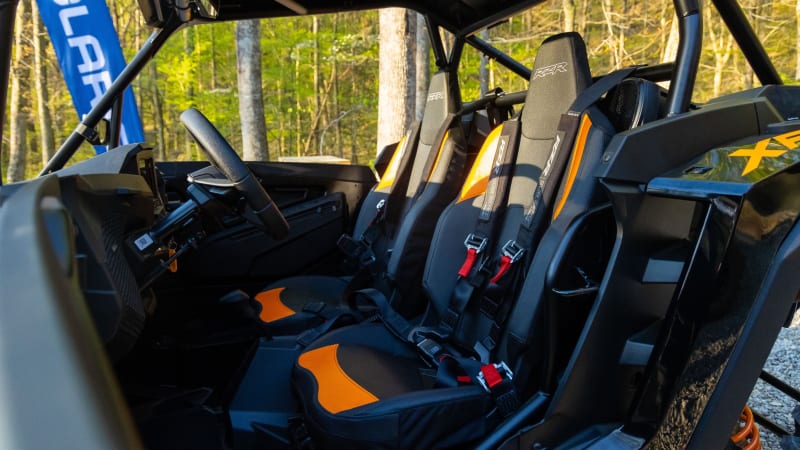
Our test unit was a two-seat model, and each of the front perches felt roomy enough for our little-over-6-foot, 230-pound driver. Over-the-shoulder four-point seat belt harnesses are manually adjustable, and a sternum strap keeps the whole unit well positioned across the chest. The seats offer good fore-aft adjustability, and the steering wheel position is also adjustable. We polled riders of differing sizes in our test group and nobody had any real comfort complaints. There’s a passenger-side grab handle that’s mounted on a quick-release slider for adjustability, and when removed it doubles as a wrench for changing wheels and tires.
Comfortable also describes the Polaris RZR XP’s ride. Walker Evans Racing Needle Shocks offer a wide range of customization via shock-mounted knobs with 16 clicks of adjustability, and their 20 inches of travel equate to 16 inches of front wheel travel and 18 inches of rear wheel travel. Ground clearance sits at 14 inches, which sounds like a lot until you encounter boulders the size of small children on the trail. Fortunately, when we did bottom out a handful of times, it didn’t result in any undue harshness, and the skid plates along the rig’s bottom prevent damage to critical components. Larger wheels and tires (Sport models get 29-inch tires, Premium and Ultimate get 30-inchers) will help alleviate grounding, especially on four-seat models with wheelbases that stretch from 90 to 117 inches.
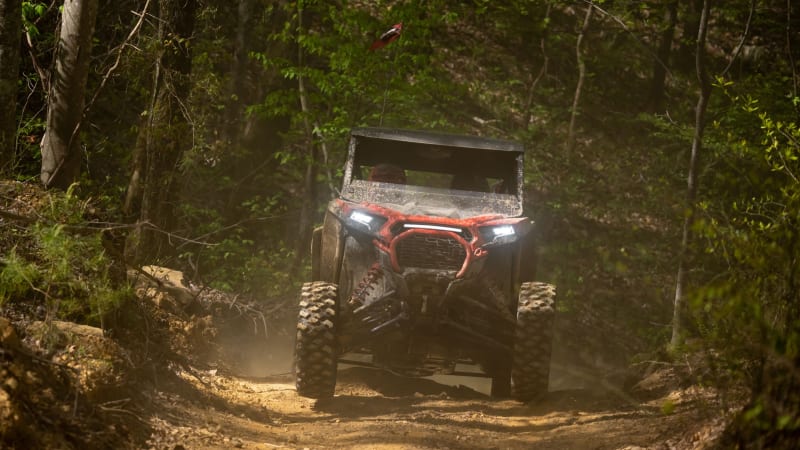
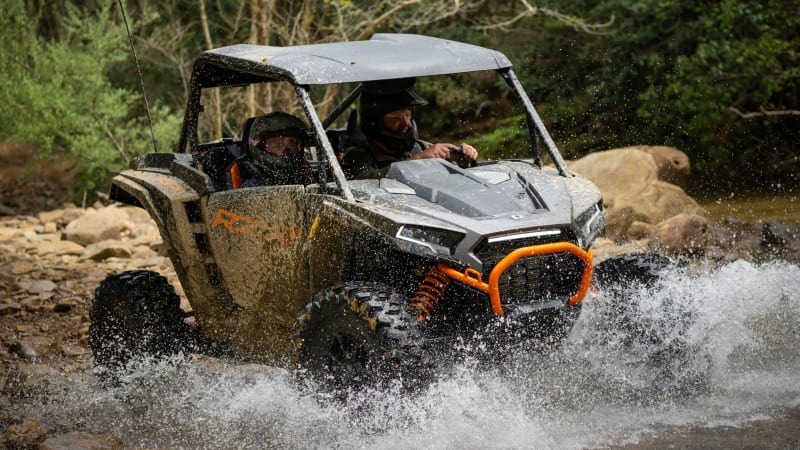
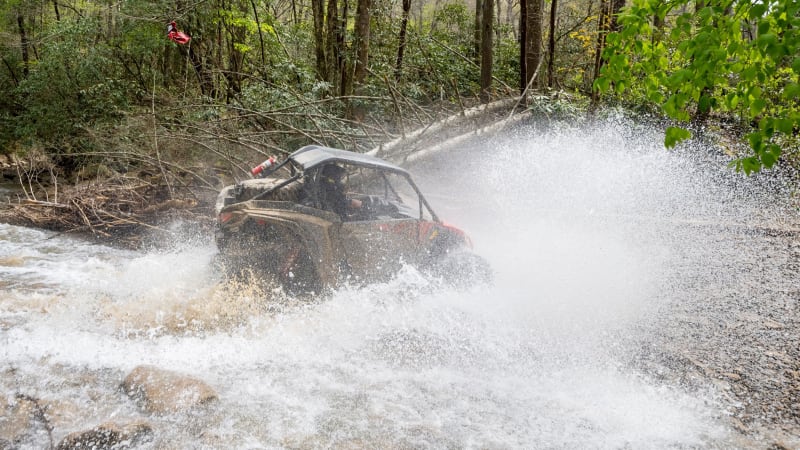
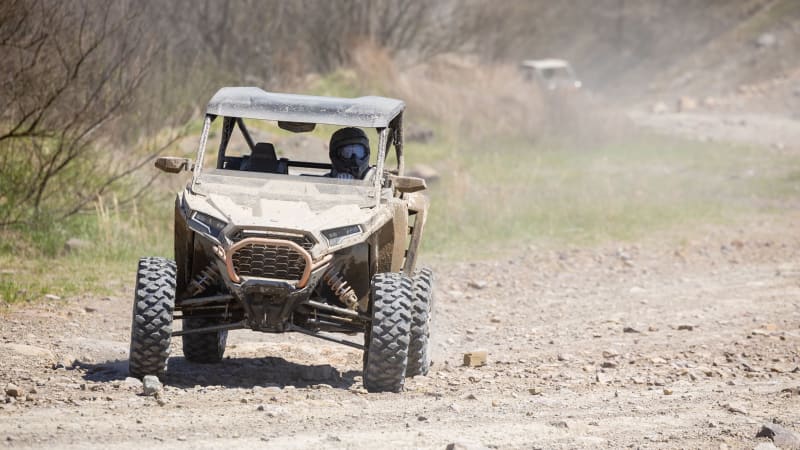
The new XP retains the original’s 64-inch width, which Polaris says represents a solid compromise between stability and maneuverability. That’s a good thing – on tight trails through the woods, there will surely be some branches twanging off the bodywork and cage as you roll through. On the other hand, if the XP were any narrower, it would feel awfully tippy-top heavy and twitchy. As it is, a quick turn at speed will produce plenty of lean, but we never felt like it might tip during our time behind the wheel.
There are two forward speeds labeled high and low, accessed by a traditional shift lever between the seats. It works fine, but the shifter’s movement is vague, like it’s moving in a pot of rubber balls. Considering it’s mostly a choose-a-gear-and-forget-it affair, that’s not too big a deal. Low gear is well chosen for long climbs as it keeps the engine in the meat of its powerband and puts less strain on the CVT, which in turn diminishes the changes of burning up transmission belts. High gear is, as its name implies, the appropriate choice for higher-speed trails that don’t have serious inclines.
The engine’s 114 ponies pale in comparison to some of Polaris’ own 200-ish-horsepower turbocharged models, but in the real world on muddy trails, it’s plenty. Bear in mind that the original Jeep Wrangler’s fuel-injected 2.5-liter four offered up 117 horsepower, and that it was tasked with lugging around a hefty chunk more than the RZR XP’s 1,500-1,900-pound dry weight. The original Mazda Miata spun out 116 hp.
More important than peak power is the engine’s tractability. It never feels like it’s lugging or working too hard, so long as you’ve selected the right gear. We didn’t perform any top-speed runs – it ought to break just about any speed limit in America, for whatever that’s worth – but it felt stable at what we’d estimate to be the 45-55 mph range. A quick bump of the throttle at low- to medium speeds results in fun tail-happy antics, and the resulting slides are very easy to control.
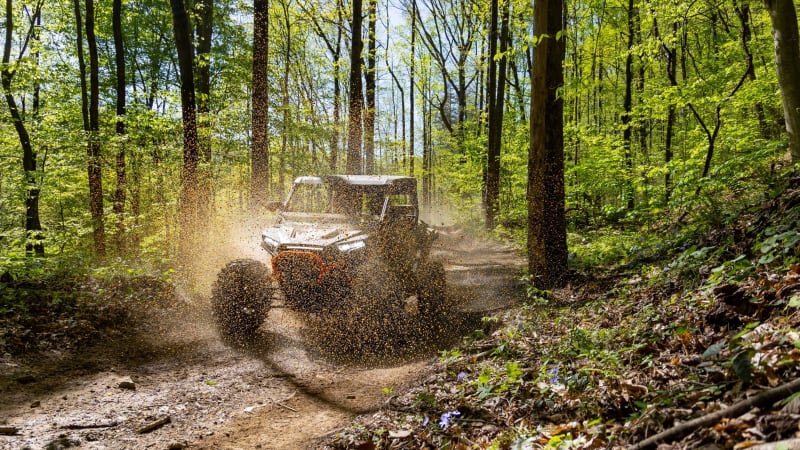
Despite the additional protection from the elements that the spiffier roof system and our unit’s optional low windshield provide over the outgoing XP, well … you will get wet on this ride if your route is splatooned with deep puddles. We got half soaked and half caked in dirt after several hours on the trails of Windrock Park in Tennessee, but that’s all part of the fun.
And that’s really what rigs like the Polaris RZR XP are all about. They may be used for transportation, exploring, hunting, and sometimes even light-duty work. But overall, they are just a blast to pilot. The RZR XP fills its mission perfectly as a solid sport side-by-side that can do just about anything you’d want to do. It’s not the fastest nor the sportiest unit available, but it covers enough of the bases that it’s almost sure to continue on as the best-selling sport ‘ute in America. Scratch that. Best-selling razor in America.



